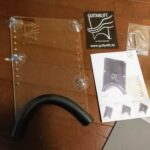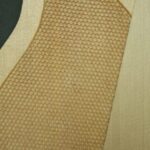One of the easiest places to make adjustments in a classical guitar is the string height. Generally speaking, the lower the string height, the easier it is to play, but is there any disadvantage? Does it have any effect on the tone? Also, I would like to write about how to measure and adjust the string height.

The articles on this site about classical guitar materials and the instrument itself are summarized in the following articles:
The proper string height is about 3mm.
It is generally said that“proper string height” for classical guitar is about 3mm at 12th fret. Of course, this is just a guideline and it can be higher or lower than this.
The proper string height is higher on the 6th string side. This is because the lower strings have a wider range of vibration and make contact with the fingerboard and frets easier.
This is higher than typical steel string guitars (2mm in general). It is because the nylon treble strings and the nylon-core bass strings on classical guitars have a higher vibration width than the steel strings on electric and acoustic guitars.
However, since nylon strings have less tension, they are not generally easier to hold down on electric and acoustic guitars.
Advantages and disadvantages of high/low string height and its effect on tone
The string height can be higher or lower, but both have their advantages and disadvantages.
In summary, it is as follows:
| Lower string height | Higher string height | |
| Strain on the left hand (fingers) | smaller | larger |
| Noise when played with strong force | easily noise occurs | noise doesn’t occur easily |
| timbre | soft | vigorous |
Characteristic of higher string height
The advantage of high string height is that the sound is not cracked even when you play hard.
The harder you pluck a string, the louder it sounds, but the more it vibrates. If the vibration becomes too loud, it will contact the fingerboard or frets and make noise. By increasing the string height, you can increase the maximum width at which this chattering sound can occur.
On the other hand, higher string height puts more stress on the left hand. The higher the string height, the more force is needed to make contact with the frets.
Also, the tone will be taut and hard. This is probably due to the fact that the higher string height results in longer string length. It’s the same principle as the sound of a short scale guitar.
lower string height
When the string height is low,the left hand becomes easy. This is probably the main purpose of people who want to lower the string height, but if the left hand becomes easier, you can play songs that you couldn’t play before, so it’s a big advantage.
On the other hand, the sound can easily be cracked when played with strong force, which can reduce the range of volume and limit the expression of the music.
It will be softer in tone. This is probably due to the short scale guitar principle mentioned above.
How to measure the string height
In general, the string height is measured at the 12th fret. The measurement is the width from the top of the fret to the bottom of the string, or the height from the open string to the point where the string touches the fret.
You can use an ordinary ruler, but it is more convenient to use a measuring instrument like this one:
It is easy to measure because there are bars on the top and bottom to measure the approximate value like this:

Also, you can see the string height with the long side down, so it’s easy to put the ruler straight against the fingerboard. With a normal ruler, you measure the string height with the short side down, but then the ruler only touches one fret, making it difficult to get a straight line.
How to adjust the string height
To adjust the string height, adjust the height of the saddle or nut. If it is too high, shave it off. If it is too low, put a thin board underneath to raise it.
It is safe to ask a specialist shop
This work is unexpectedly difficult, so the easiest way is to ask a specialist shop. This will be the most reliable way.
According to the website of Fana, a shop specializing in classical guitars, the adjustment of the saddle and nutcosts around 1000 yen and is done on the same day. I think it is a rough standard..
However, if you adjust your current nut or saddle, you won’t be able to put it back on, so you can have a new one made in the form of a spare nut or saddle. It would be nice if changing the string height changed the way you want,but there is a possibility that the previous one is better. If you think about this, you may want to ask for a spare, although it will cost you more money.
By the way, according to fana above, the price is from 7000 yen. I guess it can’t be helped that it becomes high because it takes material cost and time compared with adjustment.
If it’s an adjustment, it’s not impossible to do it on your own.
Of course, it is possible to do it yourself without asking.
Especially if you just want to lower the string height, you can simply sand the saddle and nut.
At this time, it isimportant to fill in the part to be shaved first with a magic marker or the like. The scariest thing is when you can’t cut straight rather than cutting too much. Originally the saddle is high on the 6th string side and low on the 1st string side, and this angle must be maintained. If the saddle is not shaved properly, this angle will be broken and the contact between the saddle and the bridge will not be good, which will lead to a chattering sound and a decrease in sound quality.
If you want to raise the string height, you need toput a thin sheet of paper underneath. It’s a good idea to have a string winder like this handy because you’ll be putting on and taking off strings a lot.
Making saddles and nuts is more difficult and the initial cost is higher
Making saddles and nuts on your own is highly challenging.
As for the saddle, it needs to be angled from the 1st string to the 6th string, keep that side straight, and hit the bridge straight. Also, the saddle should not be too loose or too tight in the area where the bridge saddle is stored.
As for the nut, the depth and angle of the hole through which the string passes will affect the sound. Also, the size of the hole should not be too loose or too tight.
It takes a lot of skill to make a saddle and nut that meets these requirements. Of course, the saddles and nuts you used before will remain intact, so you can do them again if they fail, but it will take a lot of time.
Another drawback is that the initial cost is surprisingly high. The materials, cow bone saddles and nuts, can usually be obtained for around $1,000.
However, you will need a saw, a vise, a file, calipers, diamond files, etc. to do the work, and it will be cheaper to ask a specialist shop to do it for you once or twice. Unless, of course, you want to do someone else’s work, or you want to make nuts and saddles as a hobby.
If you want to try it out a bit, you can shift the saddle and put it on.
If you think you should change the string height, but you don’t want to adjust it and make it worse, and it’s too expensive to make a new one, you can try changing the string height by shifting the saddle.
The saddle is slanted, so if you intentionally move the saddle to the first string side, the string height will be lower, and if you move it to the sixth string side, the string height will be higher.
However, if you overdo it, the string will slide off the saddle, and if the string is originally grooved in the middle, it will eventually fall into it. It’s only a “quick test”, but it’s a good idea to try this.
Let’s play with the right height of strings!
String height is the second easiest adjustment to make on a classical guitar, next to changing the strings, but it can be very effective.
It would be a shame to buy a guitar and use it as it is and feel that it is hard to play this classical guitar.
Why don’t you give it a try before you give up?



















